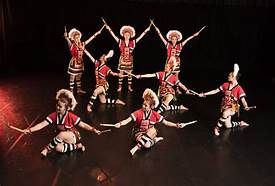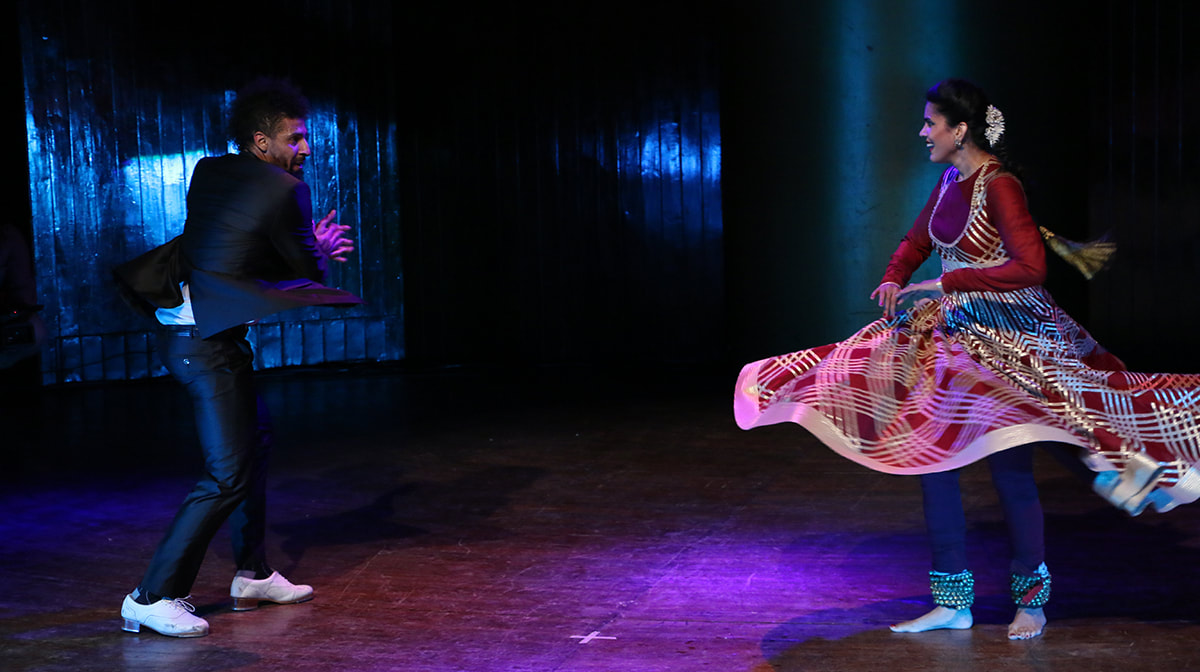|
Justin Peck's thought-provoking "The Times Are Racing," a work from 2017 that updates the vision of America. There is no better way for ballet devotees to celebrate the Memorial Day holiday than with George Balanchine’s “Stars and Stripes.”
New York City Ballet’s parade of precision military marches, set to tempo of Sousa familiar scores, is a joyous celebration of all things red, white and blue. Led on Saturday afternoon at the Koch Theater in Lincoln Center by the amazing Ashley Bouder as Liberty Bell with Harrison Ball as El Capitan, the ballet is one of those that keeps the audience smiling from start to finish. Sure, it may be a little cliché, with its batons, bugles and a waving American flag that descends in the background at the end. Yet those symbols tie it all together as a patriotic salute, a show of optimism for and loyalty to a country that promises liberty and justice for all. As we all know, however, America no longer carries the same hopefulness that was once so prevalent in our psyche when Sousa crafted his beloved marches or when Balanchine created “Stars and Stripes.” We are divided, disenfranchised and anxious -- a people struggling to connect and, too often, willing to discard those we see as other. That’s where choreographer Justin Peck’s “The Times Are Racing,” comes in. The 2017 piece – which is startling for its jarring beauty – is a thought-provoking protest song – one that urges us to push back against the labels, to see each person as part a shared DNA. We are all human, striving for love and a purpose. Peck puts it together with what appears to a ragtag group moving to an intense electronic score, “USA is a Monster” by Dan Deacon. Wearing sneakers and cutoff shorts, t-shirts, sweats and windbreakers, a dozen dancers begin in a huddle. Their group jerks downward as one (1 percent) emerges in the center, rising above the crowd. Then they all break away, running, jumping, scurrying toward something unseen. The piece then breaks into quartet (three women with Peter Walker that echoes Balanchine’s “Apollo”) and then into two duets. Ashly Isaacs and Brittany Pollack work in unison, but separately, tapping out a message of strength and will. My favorite part is the grounded pas de deux with Daniel Applebaum and Taylor Stanley who become intertwined, but responsive to each other. There is a sense of apprehension and wariness, but one of love and respect that surely speaks to those in the gay community who, until only recently, have rarely been depicted on the ballet stage. The dancer’s garb is also a billboard for the work’s message – act, protest, defy and change. While the times are racing, America still stands on a history of the people awaking and changing the political dynamics. Peck is saying now is the time, America is the place. The afternoon also served up some lighter fare – Balanchine’s cartoonish, yet fun “Slaughter of Tenth Avenue” and his tour-de-force duet “Tarantella.” Both were delightful. Andrew Veyette revealed an unseen silly side as the hoofer in “Slaughter” with Teresa Reichlen as his beloved and tragic Striptease Girl. In “Tarantella,” Daniel Ulbricht once again proved he is the company’s most charming bouncing ball. His jaunty persona paired with Balanchine’s challenging steps make for exciting theater. Erica Pereira matched his spring with her own fetching ways. It was thrilling.
0 Comments
Jason Samuels Smith and Seema Mehta in "Rhythm Rewritten: Kathak Meets Tap." They seem like an unlikely pair – tap master Jason Samuel Smith and Kathak artist Seema Mehta.
Yet with imagination, respect and joy, these two classical trained artists – from the American tradition of jazz and the ancient Hindu culture of dance and music – unspooled a surprising and enjoyable experience Saturday night at The Egg. In a program titled “Rhythm Rewritten: Kathak Meets Tap,” the two set out to demonstrate that their chosen forms have enough in common and a strong enough backbone to stand side-by-side – and battle. I admit, I approached this program with skepticism. Tap and Kathak, together? How will that work? During the first minutes of the show, I wasn’t sure it was going to work at all. This all-improvised showcase would be another forced fusion, seeking legitimacy. The first minutes of the show were devoted to Mehta who told ancient stories with her gestures. Her body spoke of lovers, of a woman warrior who fought with her baby slung to her breast and of an angry Hindu god. Listening to the intricate and expert sounds of the live musicians, singing with sitar (Jayanta Banerjee), tabla (Satyaprakash Mishra), harmonium (Dabasish Sarkar) and vocals (Joanna De Souza and Sarkar) and watching her twirling skirt flare and her hands form graceful poses, I was convinced that Mehta was so well-versed in Kathak that perhaps she could only stay in her lane. One of the more interesting things about her and all expert Kathak dancers is her ability to transform – with one spin she was a seething man, another, a sweet, timid child. These persona just appeared, real and palpable, and radiating from her being. Tap, one the other hand, was about the sound, music and rhythm. And when Mehta departed, Smith exploded onto the stage with his pianist Theo Hill (an artist who was raised and trained in the Capital Region) and bassist Ian de Souza. Smith is one of the most electric tap dancers to ever hit the boards. His athleticism is mind-boggling – he’s nearly horizon in the air when he throws his feet behind him. A few times, I was certain he would fall. He never did. He landed his sounds with accuracy. Equally entertaining was his sheer delight. Smith beamed. But nothing was more charming than Smith nailing the rhythms of the Indian musicians. Their conversation, especially between Mishra’s tabla and Smith’s feet, was incredibly complex and exuberant. Also amazing was the sounds of the jazz and Indian musicians playing together. It was powerful, like the world was waiting for them to introduce themselves. When Mehta came back for a duet with Smith, it brought it all together. Mehta matched Smith’s big presence with her precision and daring. While her bare feet can’t match the volume of Smith’s taps, she can match his moves with bells jingling on her ankles. No one – the artists or the audience – could stop smiling. It was a reach across the world that ends with mutual admiration and love. In today’s political climate, it was a respite, a brief moment of international bliss.  Da-Guan Dance Theater is lopsided. The company from the National Taiwan University of the Arts, which danced on Sunday at The Egg, is an ensemble of technically fine dancers. The troupe of 14 skillfully combines folk art with ballet, circus and martial arts to create a colorful homage to humanity and nature. The imbalance is wrought by having too few men. The four Da-Guan males are adept, even exciting. They can flip and fling themselves through the air, able acrobats all. But their dynamic tricks can’t compare to the synchronized cast of women who, dancing as a corps, created flowing scenarios that bring to mind wind and waves, power and purity. And perfection. The women, with their hefty number, swell; thus hypnotize with their fluttering fans and twirling umbrellas that they efficiently deploy into undulating visions. “Breeze” with the vibrant-colored umbrellas that looked like seedlings floating in the wind, and “Lotus Flowers” were fans flowed, were gorgeous as they constantly transformed from one image of nature to another. The women were also amazing in “Women’s Power.” Set to drums and cast in red, the rhythmic dance emphasized the oft-dismissed, but inherent strength of the female. Again, there was potency behind their sum and their ability to dance precisely as one. The men were at a disadvantage too because they had trouble harmonizing. That dissonance weakened their group works, such as the dramatic “Prayers to Heaven.” “Breaking the Cloud,” in which they wielded poles, was their best work as they were able to pull together as a team. All appeared regal in the opening number – the quiet and atmospheric “Mother Earth.” The lighting was exquisite, referencing the rising and setting sun that lent a glow to the parade of dancers in long-flowing skirts. Not all was pretty. “Joyful Childhood” was overdone and too cute. “Seven Flowers,” with the women carrying red kerchiefs, did not rise to same intriguing level of the other all-female dances. The night ended with “Impressions of Hills,” a pulsating dance with sticks and poles that brought the whole cast joyously together – a sweet send-off to the Taiwanese heritage that they so warmly preserve. |
Wendy
|


 RSS Feed
RSS Feed
